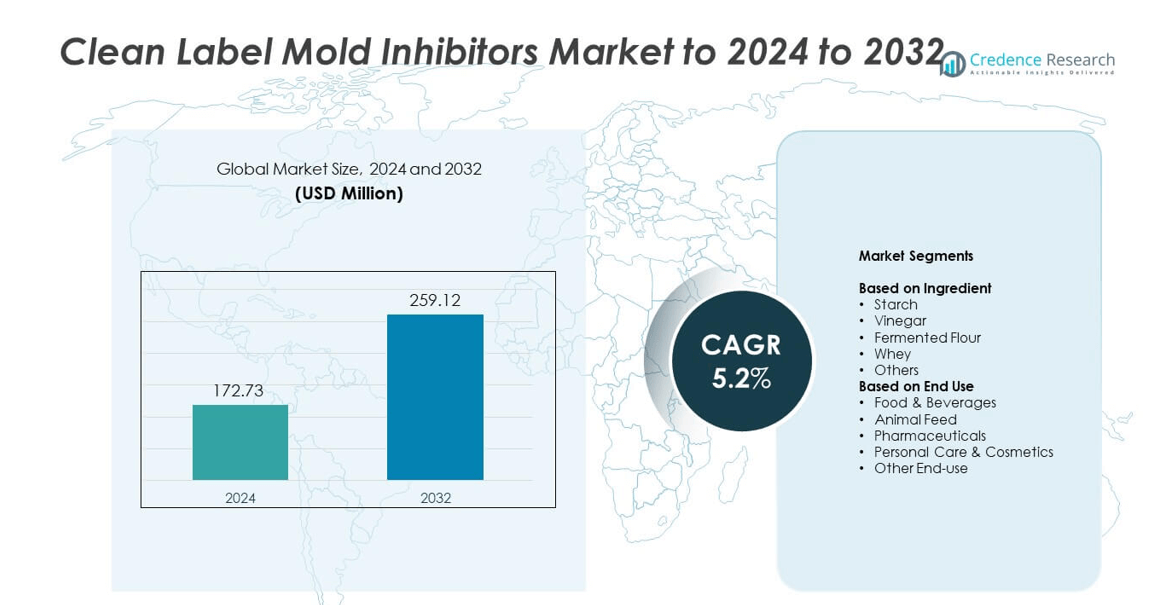1. Introduction
1.1. Report Description
1.2. Purpose of the Report
1.3. USP & Key Offerings
1.4. Key Benefits for Stakeholders
1.5. Target Audience
1.6. Report Scope
1.7. Regional Scope
2. Scope and Methodology
2.1. Objectives of the Study
2.2. Stakeholders
2.3. Data Sources
2.3.1. Primary Sources
2.3.2. Secondary Sources
2.4. Market Estimation
2.4.1. Bottom-Up Approach
2.4.2. Top-Down Approach
2.5. Forecasting Methodology
3. Executive Summary
4. Introduction
4.1. Overview
4.2. Key Industry Trends
5. Global Clean Label Mold Inhibitors Market
5.1. Market Overview
5.2. Market Performance
5.3. Impact of COVID-19
5.4. Market Forecast
6. Market Breakup by Ingredient
6.1. Starch
6.1.1. Market Trends
6.1.2. Market Forecast
6.1.3. Revenue Share
6.1.4. Revenue Growth Opportunity
6.2. Vinegar
6.2.1. Market Trends
6.2.2. Market Forecast
6.2.3. Revenue Share
6.2.4. Revenue Growth Opportunity
6.3. Fermented Flour
6.3.1. Market Trends
6.3.2. Market Forecast
6.3.3. Revenue Share
6.3.4. Revenue Growth Opportunity
6.4. Whey
6.4.1. Market Trends
6.4.2. Market Forecast
6.4.3. Revenue Share
6.4.4. Revenue Growth Opportunity
6.5. Others
6.5.1. Market Trends
6.5.2. Market Forecast
6.5.3. Revenue Share
6.5.4. Revenue Growth Opportunity
7. Market Breakup by End Use
7.1. Food & Beverages
7.1.1. Market Trends
7.1.2. Market Forecast
7.1.3. Revenue Share
7.1.4. Revenue Growth Opportunity
7.2. Animal Feed
7.2.1. Market Trends
7.2.2. Market Forecast
7.2.3. Revenue Share
7.2.4. Revenue Growth Opportunity
7.3. Pharmaceuticals
7.3.1. Market Trends
7.3.2. Market Forecast
7.3.3. Revenue Share
7.3.4. Revenue Growth Opportunity
7.4. Personal Care & Cosmetics
7.4.1. Market Trends
7.4.2. Market Forecast
7.4.3. Revenue Share
7.4.4. Revenue Growth Opportunity
7.5. Other End-use
7.5.1. Market Trends
7.5.2. Market Forecast
7.5.3. Revenue Share
7.5.4. Revenue Growth Opportunity
8. Market Breakup by Region
8.1. North America
8.1.1. United States
8.1.1.1. Market Trends
8.1.1.2. Market Forecast
8.1.2. Canada
8.1.2.1. Market Trends
8.1.2.2. Market Forecast
8.2. Asia-Pacific
8.2.1. China
8.2.2. Japan
8.2.3. India
8.2.4. South Korea
8.2.5. Australia
8.2.6. Indonesia
8.2.7. Others
8.3. Europe
8.3.1. Germany
8.3.2. France
8.3.3. United Kingdom
8.3.4. Italy
8.3.5. Spain
8.3.6. Russia
8.3.7. Others
8.4. Latin America
8.4.1. Brazil
8.4.2. Mexico
8.4.3. Others
8.5. Middle East and Africa
8.5.1. Market Trends
8.5.2. Market Breakup by Country
8.5.3. Market Forecast
9. SWOT Analysis
9.1. Overview
9.2. Strengths
9.3. Weaknesses
9.4. Opportunities
9.5. Threats
10. Value Chain Analysis
11. Porters Five Forces Analysis
11.1. Overview
11.2. Bargaining Power of Buyers
11.3. Bargaining Power of Suppliers
11.4. Degree of Competition
11.5. Threat of New Entrants
11.6. Threat of Substitutes
12. Price Analysis
13. Competitive Landscape
13.1. Market Structure
13.2. Key Players
13.3. Profiles of Key Players
13.3.1. Kerry Group plc
13.3.1.1. Company Overview
13.3.1.2. Product Portfolio
13.3.1.3. Financials
13.3.1.4. SWOT Analysis
13.3.2. Corbion N.V.
13.3.2.1. Company Overview
13.3.2.2. Product Portfolio
13.3.2.3. Financials
13.3.2.4. SWOT Analysis
13.3.3. DSM Food Specialties
13.3.3.1. Company Overview
13.3.3.2. Product Portfolio
13.3.3.3. Financials
13.3.3.4. SWOT Analysis
13.3.4. Kalsec Inc.
13.3.4.1. Company Overview
13.3.4.2. Product Portfolio
13.3.4.3. Financials
13.3.4.4. SWOT Analysis
13.3.5. Puratos Group
13.3.5.1. Company Overview
13.3.5.2. Product Portfolio
13.3.5.3. Financials
13.3.5.4. SWOT Analysis
13.3.6. Galactic
13.3.6.1. Company Overview
13.3.6.2. Product Portfolio
13.3.6.3. Financials
13.3.6.4. SWOT Analysis
13.3.7. Niacet
13.3.7.1. Company Overview
13.3.7.2. Product Portfolio
13.3.7.3. Financials
13.3.7.4. SWOT Analysis
13.3.8. Prinova Group
13.3.8.1. Company Overview
13.3.8.2. Product Portfolio
13.3.8.3. Financials
13.3.8.4. SWOT Analysis
13.3.9. BTSA Biotecnologías Aplicadas
13.3.9.1. Company Overview
13.3.9.2. Product Portfolio
13.3.9.3. Financials
13.3.9.4. SWOT Analysis
13.3.10. Sacco System
13.3.10.1. Company Overview
13.3.10.2. Product Portfolio
13.3.10.3. Financials
13.3.10.4. SWOT Analysis
13.3.11. Hawkins, Inc.
13.3.11.1. Company Overview
13.3.11.2. Product Portfolio
13.3.11.3. Financials
13.3.11.4. SWOT Analysis
13.3.12. Handary SA
13.3.12.1. Company Overview
13.3.12.2. Product Portfolio
13.3.12.3. Financials
13.3.12.4. SWOT Analysis
13.3.13. Lesaffre Corporation
13.3.13.1. Company Overview
13.3.13.2. Product Portfolio
13.3.13.3. Financials
13.3.13.4. SWOT Analysis
13.3.14. Eastman Chemical
13.3.14.1. Company Overview
13.3.14.2. Product Portfolio
13.3.14.3. Financials
13.3.14.4. SWOT Analysis
13.3.15. BioVeritas
13.3.15.1. Company Overview
13.3.15.2. Product Portfolio
13.3.15.3. Financials
13.3.15.4. SWOT Analysis
13.3.16. J&K Ingredients
13.3.16.1. Company Overview
13.3.16.2. Product Portfolio
13.3.16.3. Financials
13.3.16.4. SWOT Analysis
13.3.17. Ribus, Inc.
13.3.17.1. Company Overview
13.3.17.2. Product Portfolio
13.3.17.3. Financials
13.3.17.4. SWOT Analysis
13.3.18. Galactic Food Group
13.3.18.1. Company Overview
13.3.18.2. Product Portfolio
13.3.18.3. Financials
13.3.18.4. SWOT Analysis
13.3.19. Shenzhen Leveking Bio-Engineering Co., Ltd.
13.3.19.1. Company Overview
13.3.19.2. Product Portfolio
13.3.19.3. Financials
13.3.19.4. SWOT Analysis
13.3.20. Kemin Industries, Inc.
13.3.20.1. Company Overview
13.3.20.2. Product Portfolio
13.3.20.3. Financials
13.3.20.4. SWOT Analysis
14. Research Methodology








